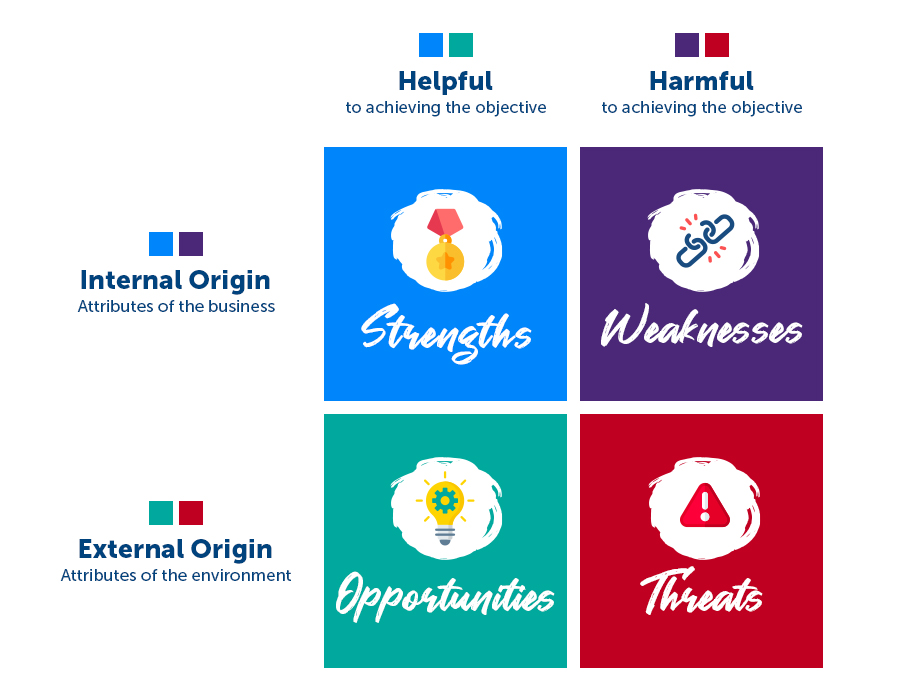If you’ve been in business for a while or have ever opened a textbook for a business course, you may have heard of the term “SWOT analysis.” A SWOT analysis is a tool to help you identify the Strengths, Weaknesses, Opportunities, and Threats for a company, new product, or new service; anything really that requires strategy or planning.
By going through this analysis, you will become super aware of what does or can impact your company. You can then use this information to create a strategy that increases the likelihood of your business’s success.

Let’s start with the internal factors (aka strengths and weaknesses) that impact your business. For example, imagine you’re a graphic designer who is starting their own business. You are highly skilled, have over 15 years of agency experience, and have a distinct design style that has gained you a strong social media following. These are strengths. On the other hand, despite being very talented, you lack confidence in interacting with clients and sometimes under-price yourself. These are weaknesses that you need to work on.
Now let’s explore external factors that can impact a company, known as opportunities and threats. Keeping with the same example of the newly formed graphic design business, imagine that your city has a booming small business community with frequent small business meetups, outdoor markets, and networking events. Each of these external factors presents an opportunity for you to grow your business by connecting with business owners around you. While there are many opportunities for new customers, you know a lot of companies are turning to websites that provide low-cost graphic design solutions, making it more challenging to pitch fair pricing for custom design work. These websites are threats to your business. To overcome them, you will need a strong value statement and strategy to show your customers why they are better off to go with your services over the less costly alternatives.
That was just a brief example of information you may discover by performing a SWOT analysis. Next, let’s go through each section more in-depth, so you are prepared to conduct your own!
Internal Factors
Strengths
Strengths are those positive, awesome things you have going for your company. They are internal factors directly tied to the business itself through its products, your team’s skillset/experience, or anything else about your business that would give you an advantage over the competition.
Weaknesses
Weaknesses may detract from your strengths, and often require that you find a way to overcome them to be more competitive.
Questions to Identify Your Strengths and Weaknesses
Below are a few questions to help identify strengths and weaknesses. Depending on the response, the answer could reveal a strength or a weakness.
- What areas or processes of your business are strong? What areas are not performing well?
- Are your supplies or inventory low-cost or expensive for what you offer?
- What competitive advantages do you have over others in your industry?
- What about your products is unique?
- Is overhead (the people cost) for your business very high, relative to profits?
- Is your physical location ideal for you to serve the right customers?
- Is there a lot of risks associated with what you offer (physical or financial)?
- What experience, knowledge, or skills do you or your team bring to the business?
- What sort of physical property does your company have available, such as equipment, technology, financial-backing, etc.?
External Factors
Opportunities
Opportunities are external factors that can positively impact your business. They have the potential to contribute to your overall success if you go for them!
Threats
Alternatively, threats are external factors that can negatively impact your business. You may have very little direct control over these threats, so you will need to strategize how to overcome them (should they become an issue).
Questions to Identify Your Opportunities and Threats
Below are questions to help you identify opportunities and threats. Just like before, depending on the response, the answer is either an opportunity or a threat.
- Are there any events coming up that you can be involved with and will attract members of your target audience?
- Are you in a high-demand market due to trends or changes in customer preference?
- What do people think of you, your business, or the products/services you offer?
- Is there a shortage in the market that you can look to fill?
- Are your supplies easy or difficult to locate?
- Is your market highly saturated?
- Is your business seasonal, so during certain times there is less customer demand?
- Could your business *potentially* be replaced by technology?
Answer each of these questions to help identify internal and external factors that impact your business (in doing so, you may come up with additional questions of your own). Once complete, you will have a strong foundation for your SWOT analysis.
Top 5 tips for a super successful SWOT:
1. Bring in multiple points of view.
By diversifying, who is involved in this exercise, you will ensure that you analyze the business thoroughly, through different perspectives. If you are a single person company, you can still do this by focusing on each area of your business separately or asking for help from a friend or family member who knows your business well.
2. Don’t rush.
While it is tempting to rush through a task like this so that you can get back to the fun things you are really passionate about, you are much better off dedicating time and energy to performing your SWOT analysis well. That said, don’t burn yourself out; spend a few hours on your SWOT analysis and then take a break (maybe even for a day or two).
3. Focus on the things with the most significant potential or impact.
You may identify strengths that are hugely impactful, while other things might just be positive FYIs. Equally, there may be an area of your business that is somewhat of weakness but has a low-risk factor. Because performing a SWOT analysis will result in a lot of information for each category, really focus your attention on the things that have the most substantial potential to impact how your business performs.
4. Act on your findings.
Once you have identified the top items in each section, come up with a plan of action. For example, if a threat to your business is that you are in a saturated market with low demand, start working on a value statement and plan to differentiate yourself amongst competitors, and get yourself in front of as many customers as possible. Or maybe find a way to position your business differently in a way that will also increase demand. Sometimes the hardest part of acting on things is just getting started, so if that’s the case, listen to our podcast episode here that focuses on just that. Remember, knowledge is just a bunch of facts and information until it’s utilized.
5. Revisit your SWOT analysis as frequently as needed.
You know your company best, and depending on how much things change for your business, industry, and customers, you may only need to revisit your SWOT analysis every 6 months or once a year. If you are in a highly variable or seasonal industry, it may be helpful to visit your SWOT analysis as you approach each season.
So with that, we hope this overview of SWOT analysis has you excited to sit down with some coffee (and maybe a few colleagues) to really get to know your business in a totally new and super-organized way.
We are cheering you on and wish you all the success!






